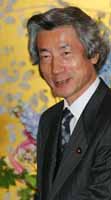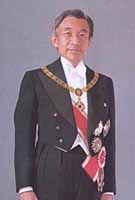 |
|||||
 |
|||||
 |
|||||
 |
|||||
 |
|||||
 |
|||||
 |
|||||
 |
|||||
 |
|||||
 |
|||||
 |
|||||
 |
|||||
 |
|||||
 |
|||||

Modern Japanese Government |
|
||||||||||||||||||||||||||||||||||||||||||||||||||||||||||||||||||||||||||||||||||||||||||||||||||
 |
||||||||||||||||||||||||||||||||||||||||||||||||||||||||||||||||||||||||||||||||||||||||||||||||||
A Joint Session of the Japanese Diet |
||||||||||||||||||||||||||||||||||||||||||||||||||||||||||||||||||||||||||||||||||||||||||||||||||
LEGISLATIVE | EXECUTIVE | JUDICIAL | THE EMPEROR
LEGISLATIVE
The legislative branch is Japan's
parliament. Called the Diet, has complete
political power. The Diet is a bicameral legislature.
The upper house is called the House of Concillors while the lower house is
called the House of Representatives. Both are made up of elected representatives.
It is made up of representatives of the people. The responsibilities of the
Diet include making laws, approving the budget, and ratifying treaties. If
the Diet feels a constitutional
amendment is needed, they may write it and then have it presented to
the people in a referendum.
It may also investigate the government. The prime minister is designated
by the Diet. Below is a chart outlining some basic information about the
two houses of the Japanese Parliament.
| Category | House of Representatives | House of Councillors |
| term of office | four years | six years |
| powers |
|
|
| process of election | Every four years, the whole house is elected | Every three years, half the house is elected. |
| Current number of members | 512 | 252 |
| Determination of members | 130 different areas with multiple representatives. | prefectural population and national proportional representation |
| Requirements | twenty-five years old | thirty years of old |
EXECUTIVE
 The
Executive Branch of the Japanese government is the cabinet. The head of the cabinet
if the prime minister.
There are three major areas with other ministries and agencies that comprise
the Executive Branch. Some of the Ministries include agriculture, education,
finance, labor and transportation. Some of the Agencies include the Defense
Agency, Environmental Agency, National Public Safety Commission, and Fair
Trade Commission. The Board of Audit is responsible for reviewing government
expenses and gives an annual report to the Prime Minister. Below is a table
of major cabinet titles and their responsibilities. At right is the current Prime
Minister Junichiro Koizumi.
The
Executive Branch of the Japanese government is the cabinet. The head of the cabinet
if the prime minister.
There are three major areas with other ministries and agencies that comprise
the Executive Branch. Some of the Ministries include agriculture, education,
finance, labor and transportation. Some of the Agencies include the Defense
Agency, Environmental Agency, National Public Safety Commission, and Fair
Trade Commission. The Board of Audit is responsible for reviewing government
expenses and gives an annual report to the Prime Minister. Below is a table
of major cabinet titles and their responsibilities. At right is the current Prime
Minister Junichiro Koizumi.
| Office | Job Responsibilities |
| Prime Minister |
|
| Chief Cabinet Secretary |
|
| Director of the Cabinet Legislative Bureau |
|
| The Security Council |
|
JUDICIAL
Within the Japanese legal system,
there is a Supreme Court, High Courts, District Courts, Family Courts and Summary
Courts. The highest court of Japan is the Supreme Court. It is the final
court
of appeal for both civil and criminal cases. Decisions are made by either fifteen
justices (a grand bench) or five justices (petite bench). Any case determining
constitutionality must have a grand bench decision. The Supreme Court Justices
can be removed by
a majority of voters in a referendum that occurs at the first general election
following the justice's appointment and every ten years thereafter. The Supreme
Court has many responsibilities in Japan. The most difficult is to determine
the constitutionality of any law, order, regulation, or official act. They
are
also responsible for
nominating lower court judges, determining judicial procedures, overseeing
the judicial
system, disciplining judges and other judicial personnel. The judicial system
includes eight high courts, fifty district courts and fifty family courts.
Summary courts exist in cities and perform functions similar to US small courts
and justices of the peace.
THE EMPEROR
 Until
the end of World War II, the Japanese emperor was considered to be divine.
On January 1, 1946 Emperor
Hirohito made a speech at General Mac Arthur's request. In the speech, he renounced
his status as a divine ruler. He also stated that the relationship between
the emperor and the people of Japan cannot be based on "the false conception
that the emperor is divine or that the Japanese people are superior to other
races."
The emperor was then seen as
a symbol of the state who received power from the people. The Emperor's duties
became very specific and ceremonial as opposed to very broad. While the emperor
no longer has an official religious role, he performs ancient rituals like the
ceremonial planting of the rice crop in the spring. After World War II the imperial family's
estates were confiscated and all finances dealing with the emperor were put under
the control of the Imperial Household Agency. This agency is part
of the Office of the Prime Minister and is controlled by the Diet. The succession
of the emperor is to pass to male children. The present emperor, Hirohito's son
Akihito as seen above. The current Crown Prince
Naruhito and his wife have only
a
girl child. This may cause a problem in the line of succession. The Japanese
government
announced
in 2005 that they would consider allowing the royal couple to adopt a male child.
Many
of
the
ceremonies
the
emperor
takes
part
in are of a religious nature and cannot be supported by the state.
Until
the end of World War II, the Japanese emperor was considered to be divine.
On January 1, 1946 Emperor
Hirohito made a speech at General Mac Arthur's request. In the speech, he renounced
his status as a divine ruler. He also stated that the relationship between
the emperor and the people of Japan cannot be based on "the false conception
that the emperor is divine or that the Japanese people are superior to other
races."
The emperor was then seen as
a symbol of the state who received power from the people. The Emperor's duties
became very specific and ceremonial as opposed to very broad. While the emperor
no longer has an official religious role, he performs ancient rituals like the
ceremonial planting of the rice crop in the spring. After World War II the imperial family's
estates were confiscated and all finances dealing with the emperor were put under
the control of the Imperial Household Agency. This agency is part
of the Office of the Prime Minister and is controlled by the Diet. The succession
of the emperor is to pass to male children. The present emperor, Hirohito's son
Akihito as seen above. The current Crown Prince
Naruhito and his wife have only
a
girl child. This may cause a problem in the line of succession. The Japanese
government
announced
in 2005 that they would consider allowing the royal couple to adopt a male child.
Many
of
the
ceremonies
the
emperor
takes
part
in are of a religious nature and cannot be supported by the state.
Click here to see a diagram of Japanese Government.
to return to Mrs. O'Donnell's Home Page.
Maintained according to the Lakeland
Central School District Web Page Policies and Guidelines.
This
site was designed and maintained by Maureen
O'Donnell, a teacher at Lakeland
High School.
July 2005 Created - |
Saturday, February 25, 2006
Last Revised